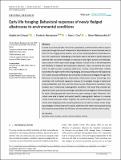Por favor, use este identificador para citar o enlazar a este item:
http://hdl.handle.net/10261/153753COMPARTIR / EXPORTAR:
 SHARE SHARE
 CORE
BASE CORE
BASE
|
|
| Visualizar otros formatos: MARC | Dublin Core | RDF | ORE | MODS | METS | DIDL | DATACITE | |

| Título: | Early-life foraging: Behavioral responses of newly fledged albatrosses to environmental conditions |
Autor: | de Grissac, Sophie; Bartumeus, Frederic CSIC ORCID ; Cox, Sam L.; Weimerskirch, Henri | Palabras clave: | Seabirds Tracking Diomedea exulans Ecology Juveniles Learning |
Fecha de publicación: | 2017 | Editor: | John Wiley & Sons | Citación: | Ecology and Evolution : DOI:10.1002/ece3.3210 (2017) | Resumen: | In order to survive and later recruit into a population, juvenile animals need to acquire resources through the use of innate and/or learnt behaviors in an environment new to them. For far-ranging marine species, such as the wandering albatross Diomedea exulans, this is particularly challenging as individuals need to be able to rapidly adapt and optimize their movement strategies in response to the highly dynamic and heterogeneous nature of their open-ocean pelagic habitats. Critical to this is the development and flexibility of dispersal and exploratory behaviors. Here, we examine the movements of eight juvenile wandering albatrosses, tracked using GPS/Argos satellite transmitters for eight months following fledging, and compare these to the trajectories of 17 adults to assess differences and similarities in behavioral strategies through time. Behavioral clustering algorithms (Expectation Maximization binary Clustering) were combined with multinomial regression analyses to investigate changes in behavioral mode probabilities over time, and how these may be influenced by variations in day duration and in biophysical oceanographic conditions. We found that juveniles appeared to quickly acquire the same large-scale behavioral strategies as those employed by adults, although generally more time was spent resting at night. Moreover, individuals were able to detect and exploit specific oceanographic features in a manner similar to that observed in adults. Together, the results of this study suggest that while shortly after fledging juvenile wandering albatrosses are able to employ similar foraging strategies to those observed in adults, additional skills need to be acquired during the immature period before the efficiency of these behaviors matches that of adults. | Descripción: | Este artículo contiene 13 páginas, 5 figuras, 2 tablas. | Versión del editor: | http://dx.doi.org/10.1002/ece3.3210 | URI: | http://hdl.handle.net/10261/153753 | DOI: | 10.1002/ece3.3210 | ISSN: | 2045-7758 | E-ISSN: | 2045-7758 |
| Aparece en las colecciones: | (CEAB) Artículos |
Ficheros en este ítem:
| Fichero | Descripción | Tamaño | Formato | |
|---|---|---|---|---|
| deGrissac 2017.pdf | 880,76 kB | Adobe PDF |  Visualizar/Abrir |
CORE Recommender
PubMed Central
Citations
18
checked on 10-abr-2024
SCOPUSTM
Citations
43
checked on 16-abr-2024
WEB OF SCIENCETM
Citations
43
checked on 21-feb-2024
Page view(s)
290
checked on 14-abr-2024
Download(s)
260
checked on 14-abr-2024
Google ScholarTM
Check
Altmetric
Altmetric
Artículos relacionados:
NOTA: Los ítems de Digital.CSIC están protegidos por copyright, con todos los derechos reservados, a menos que se indique lo contrario.


